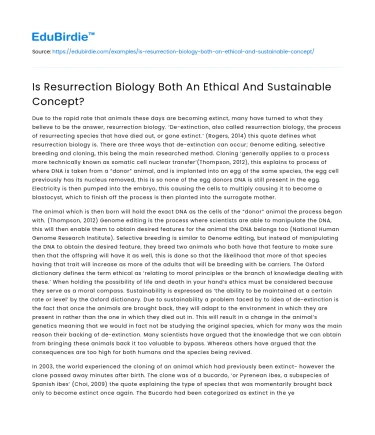Introduction
Resurrection biology, often dubbed 'de-extinction,' is a burgeoning field that has captured the imaginations of scientists and the public alike. This new scientific frontier aims to bring extinct species back to life, using advanced genetic techniques such as cloning and CRISPR-Cas9 gene editing. The potential benefits of resurrection biology are manifold; it could restore ecosystems, enhance biodiversity, and provide unique opportunities for scientific study. However, the concept also raises profound ethical and sustainability questions. Is it morally justifiable to resurrect species that nature has selected for extinction? And does the practice offer a sustainable solution to the current biodiversity crisis? This essay will explore these questions, analyzing the ethical implications and sustainability of resurrection biology, while addressing counter-arguments to present a balanced view.
Ethical Considerations in Resurrection Biology
The ethical dimensions of resurrection biology are complex and multifaceted, often drawing from various philosophical, ecological, and moral frameworks. One primary ethical concern is the question of playing God. Critics argue that human intervention in the natural order, especially through genetic manipulation, is inherently unethical. According to ethicist Bernard Rollin, "The power to manipulate the genetic makeup of extinct species raises significant moral concerns, akin to wielding a double-edged sword." The potential for unintended consequences, such as the introduction of resurrected species into ecosystems where they may become invasive, further complicates the ethical landscape.
Save your time!
We can take care of your essay
- Proper editing and formatting
- Free revision, title page, and bibliography
- Flexible prices and money-back guarantee
Furthermore, there is the moral obligation to prioritize existing species that are on the brink of extinction. With limited resources, some argue that conservation efforts should focus on preserving the biodiversity we currently have rather than resurrecting what has been lost. The ethical principle of "do no harm" may be violated if de-extinction diverts attention and funding away from critical conservation efforts. However, proponents like Stewart Brand, founder of the Long Now Foundation, suggest that resurrection biology can serve as a "genetic backup" for biodiversity, enhancing the resilience of ecosystems against future challenges.
Transitioning from ethical concerns, it is crucial to consider the potential benefits and drawbacks of resurrection biology in terms of ecological sustainability. While ethics provide a moral compass, sustainability offers a pragmatic evaluation of whether de-extinction can be integrated into long-term biodiversity strategies.
Sustainability and Ecological Impact
Sustainability in resurrection biology revolves around whether the practice can be maintained over time without depleting resources or causing ecological imbalance. Proponents argue that bringing back extinct species could restore lost ecological functions and increase biodiversity. For example, the reintroduction of the woolly mammoth to the tundra has been proposed to combat climate change by transforming the ecosystem in ways that sequester carbon more effectively. Such initiatives, if successful, could offer new tools for ecological restoration.
However, the sustainability of resurrection biology is contested. Critics point out that successfully resurrected species might not integrate well into contemporary ecosystems, which have evolved in their absence. The ecological niche that a species once occupied could have been filled by other organisms, leading to competition and possibly new extinctions. Additionally, the long-term viability of resurrected populations is uncertain, as they may lack genetic diversity or face challenges from modern diseases.
Transitioning to the broader implications of sustainability, it is important to address the economic and social dimensions of resurrection biology, which influence its feasibility and acceptance. While ecological sustainability is paramount, the concept must also align with societal values and economic realities to be considered viable.
Economic and Social Implications
The economic feasibility of resurrection biology is a critical consideration. The costs associated with de-extinction are substantial, involving sophisticated technology and extensive research. Critics argue that these resources could be better spent on traditional conservation methods, which have proven success in preserving endangered species. Moreover, the economic benefits of de-extinction are uncertain. While resurrected species might attract tourism and generate interest, the financial returns may not justify the initial investment.
Socially, resurrection biology presents both opportunities and challenges. The idea of bringing back extinct species captivates the public imagination, potentially fostering greater interest in conservation and environmental issues. However, it also raises questions about the human relationship with nature. As philosopher Christopher Preston notes, "Resurrection biology challenges our conception of the 'natural,' blurring the line between human intervention and natural processes." This shift could alter societal perceptions of conservation, emphasizing technological solutions over traditional ecological stewardship.
Transitioning to the conclusion, it is evident that resurrection biology is a concept rich with potential yet fraught with complexities. Balancing ethical considerations, sustainability, economic viability, and societal acceptance will determine its role in the future of biodiversity conservation.
Conclusion
In conclusion, resurrection biology presents an intriguing yet contentious proposition that intersects ethics, sustainability, economics, and societal values. While the idea of bringing extinct species back to life holds promise for biodiversity restoration and scientific advancement, it is not without significant ethical and practical challenges. The ethical concerns about human intervention and resource allocation must be carefully weighed against potential ecological benefits. Furthermore, the sustainability of integrating resurrected species into contemporary ecosystems remains an open question, demanding rigorous scientific evaluation. As we navigate the complexities of resurrection biology, a balanced approach that considers both traditional conservation methods and innovative technologies will be essential. Ultimately, the future of resurrection biology will depend on our collective ability to address these multifaceted issues thoughtfully and responsibly.






 Stuck on your essay?
Stuck on your essay?

